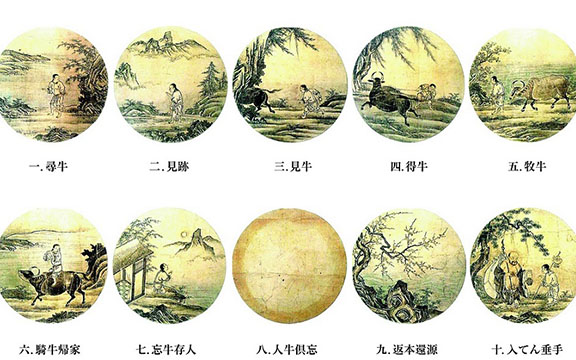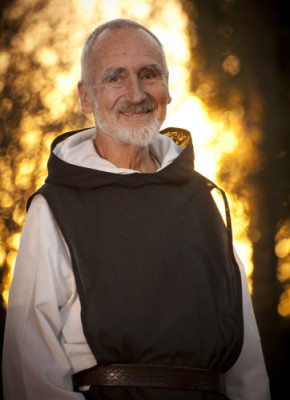
(Ilustration from the classic “Ten Oxherding Pictures” teaching story.)
In this essay, Br. David Steindl-Rast, OSB, reflects on how we make ourselves whole by making each other whole. He explores the classic teaching story “Ten Oxherding Pictures” from the Zen Buddhist tradition.
Wholeness has intrigued me ever since we boys built sandcastles on the beach. You built a perfect world. You surrounded it with a moat. You looked up and there was some incongruous beach chair, a blanket, or simply somebody’s leg, out of scale and totally out of context. No way to bring this out-of-bounds reality into your wholeness. So I learned the lesson early on: Wholeness is not truly whole until it is all-inclusive.
Later, this insight gave me a key to the “Ten Oxherding Pictures” in Zen; to the last two of them, to be precise. Up to number eight all is clear. Oxherding is a misnomer. But when we know that the series depicts the taming of a wild buffalo, the first seven frames make sense. And once we realize that this metaphor stands for the path to inner wholeness, number eight falls into place, too. What could express wholeness better than this circle, perfect and perfectly empty?
As long as this question remains merely rhetorical, the series ends there. And for a long time it did so, I am told. Then someone raised the question in earnest. Is there a wholeness that goes beyond the point where the Buddha enters nirvana? The answer took shape in the Bodhisattva, who at this point turns and vows not to enter nirvana, but to labor till the last of all beings has reached nirvana.
The great death is revealed as life, the great emptiness as fullness.
Now, two more frames were added to the series. Number nine shows the other side, as it were, of number eight: The empty circle is filled. In no other frame does the imagery vary more widely. But the meaning is always exuberant fullness. In my favorite version, the circle holds an abundance of blossoms. The great death is revealed as life, the great emptiness as fullness. The final frame shows the Bodhisattva in the marketplace. A beggar with beggars, with fishmongers: the one who realized our original wholeness feasting and belly-laughing with outcasts. (“A friend of sinners,” they called Jesus.)
How different, this all-embracing wholeness of the Boddhisattva from the hero who finds wholeness by passing through hell and then lives happily ever after! But is this really what the hero myth tells? Where the myth remains intact, the hero returns to a community, returns as bringer of life for many. Only in a classic Western does he ride off into the sunset, alone. (Any anthropologist will wonder what warped culture produced so warped a version of the hero myth.)
Rilke uncovers wholeness even in the violent end of Orpheus. Did the maenads in their madness tear him limb from limb? They distributed him, Rilke claims, as bread is broken and distributed: a holy communion. Scattered, he keeps singing in every song that sounds. “Take, eat, this is my body given for you.” But eating of this bread takes courage, courage to become in one’s own turn bread for the world.
No wonder Jesus asks before he heals, “Do you want to be made whole?” We know the price of wholeness. Are we willing to become bread in a world where each new sunrise sees the corpses of 50,000 starved children? Wholeness must be all embracing. Do you want to become whole?
About the Author:
 Br. David Steindl-Rast joined a newly founded Benedictine community in Elmira, NY, Mount Saviour Monastery, where he became “Brother David,” in 1953. In 1958/59 Brother David was a Postdoctoral Fellow at Cornell University, where he also became the first Roman Catholic to hold the Thorpe Lectureship, following Bishop J.D.R. Robinson and Paul Tillich. After twelve years of monastic training and studies in philosophy and theology, Brother David was sent by his abbot to participate in Buddhist-Christian dialogue, for which he received Vatican approval in 1967. His Zen teachers were Hakuun Yasutani Roshi, Soen Nakagawa Roshi, Shunryu Suzuki Roshi, and Eido Shimano Roshi. He co-founded, with Swami Satchidananda, the Center for Spiritual Studies in 1968 and received the 1975 Martin Buber Award for his achievements in building bridges between religious traditions. Together with Thomas Merton, Brother David helped launch a renewal of religious life. From 1970 on, he became a leading figure in the House of Prayer movement, which affected some 200,000 members of religious orders in the United States and Canada. At present, Brother David serves a worldwide Network for Grateful Living, through Gratefulness.org, an interactive website with several thousand participants daily from more than 240 countries and territories.
Br. David Steindl-Rast joined a newly founded Benedictine community in Elmira, NY, Mount Saviour Monastery, where he became “Brother David,” in 1953. In 1958/59 Brother David was a Postdoctoral Fellow at Cornell University, where he also became the first Roman Catholic to hold the Thorpe Lectureship, following Bishop J.D.R. Robinson and Paul Tillich. After twelve years of monastic training and studies in philosophy and theology, Brother David was sent by his abbot to participate in Buddhist-Christian dialogue, for which he received Vatican approval in 1967. His Zen teachers were Hakuun Yasutani Roshi, Soen Nakagawa Roshi, Shunryu Suzuki Roshi, and Eido Shimano Roshi. He co-founded, with Swami Satchidananda, the Center for Spiritual Studies in 1968 and received the 1975 Martin Buber Award for his achievements in building bridges between religious traditions. Together with Thomas Merton, Brother David helped launch a renewal of religious life. From 1970 on, he became a leading figure in the House of Prayer movement, which affected some 200,000 members of religious orders in the United States and Canada. At present, Brother David serves a worldwide Network for Grateful Living, through Gratefulness.org, an interactive website with several thousand participants daily from more than 240 countries and territories.

